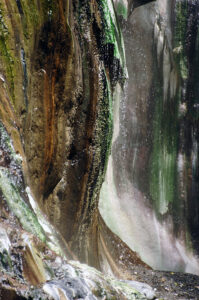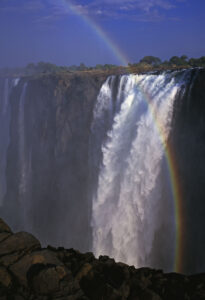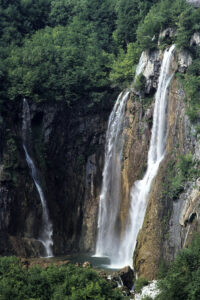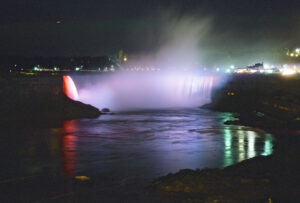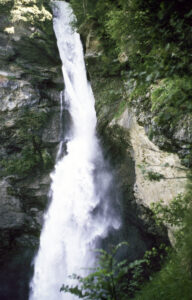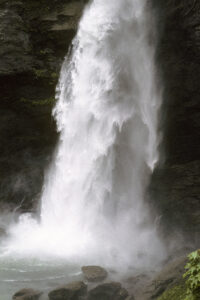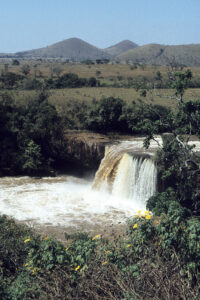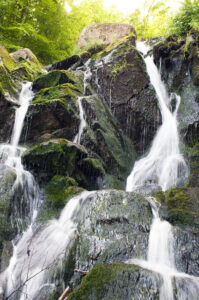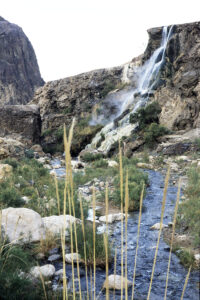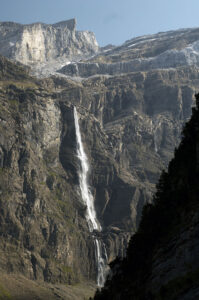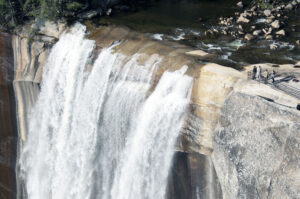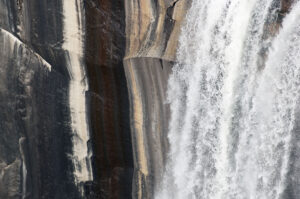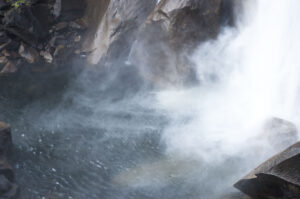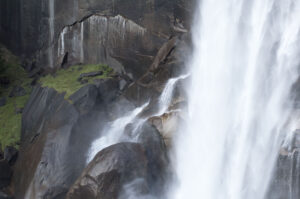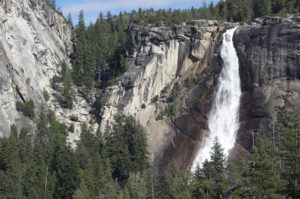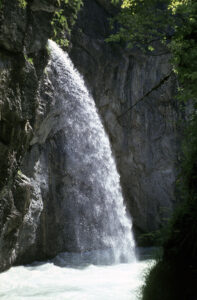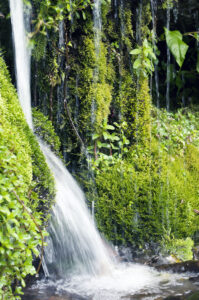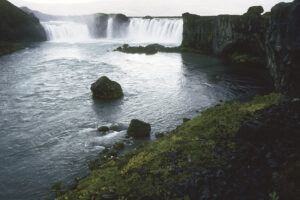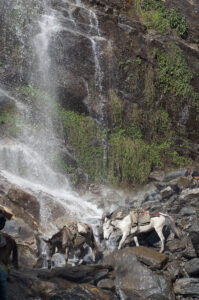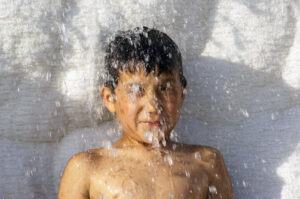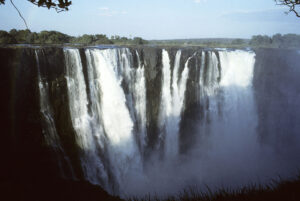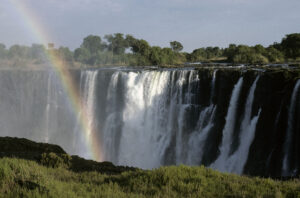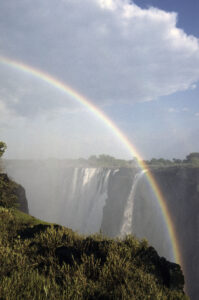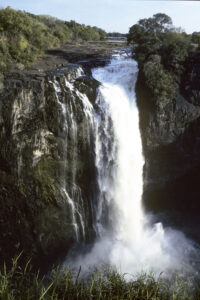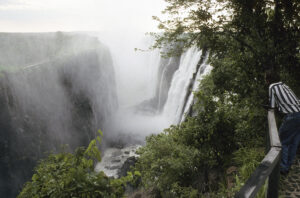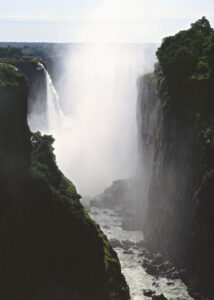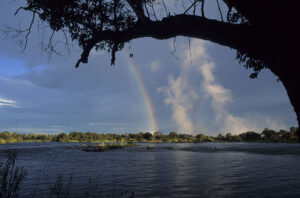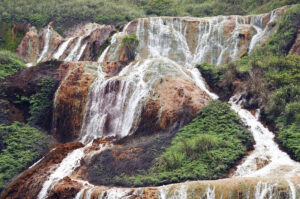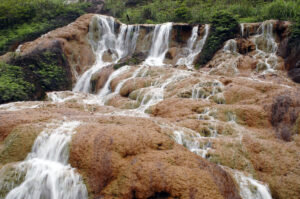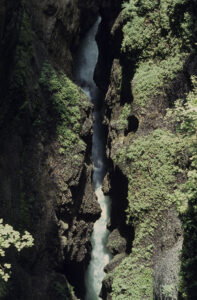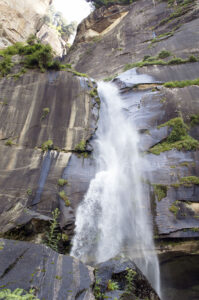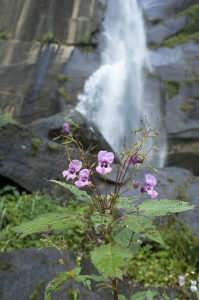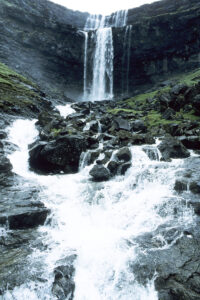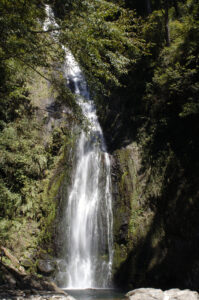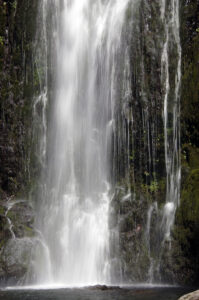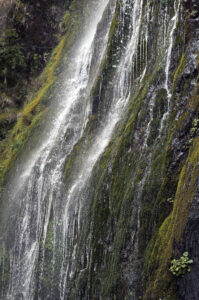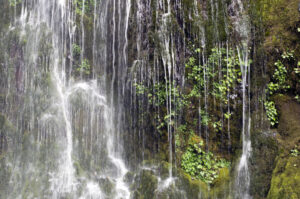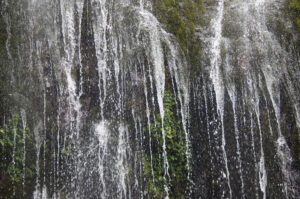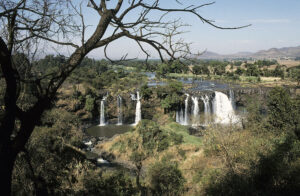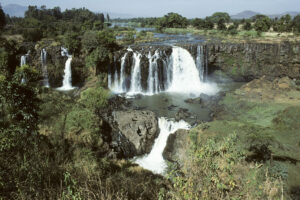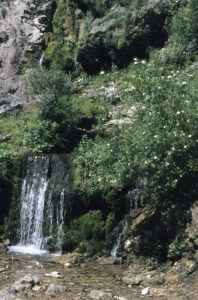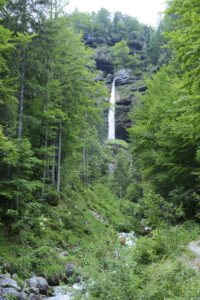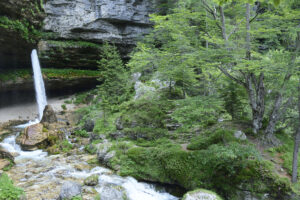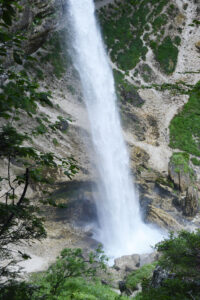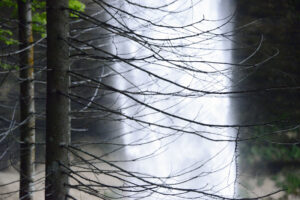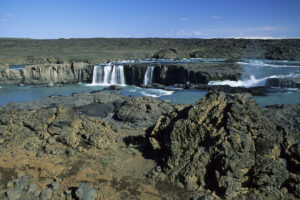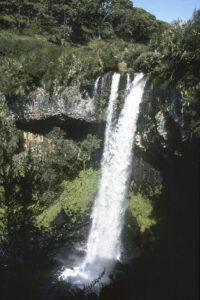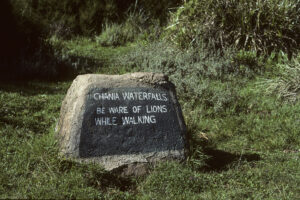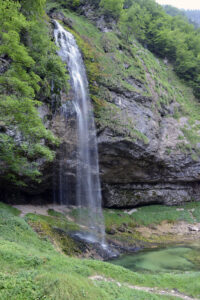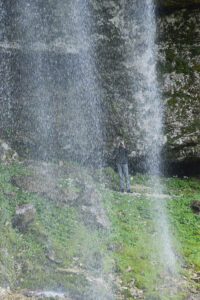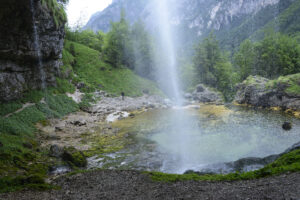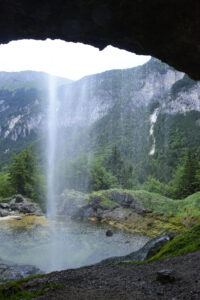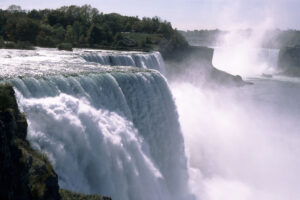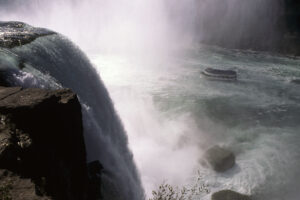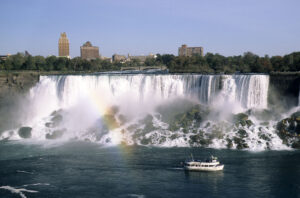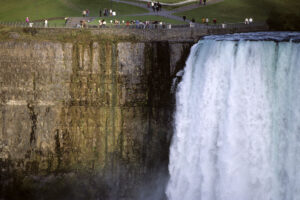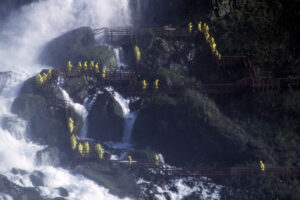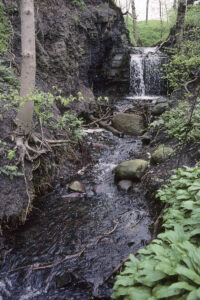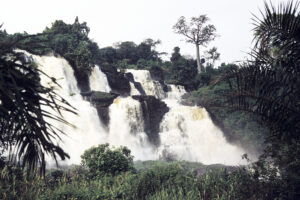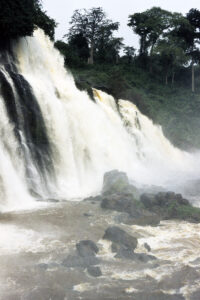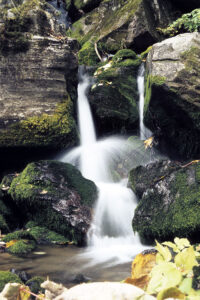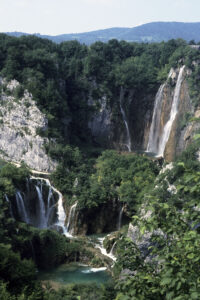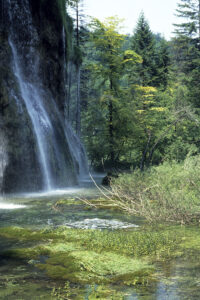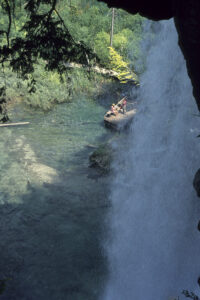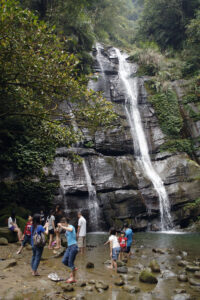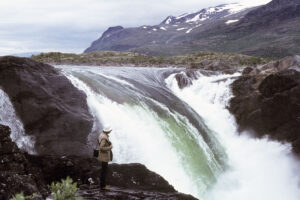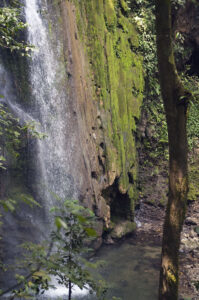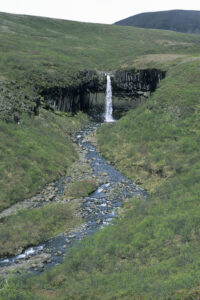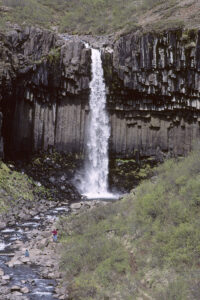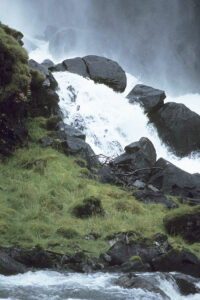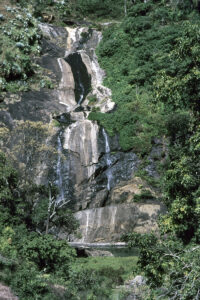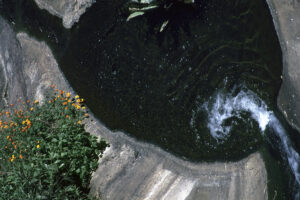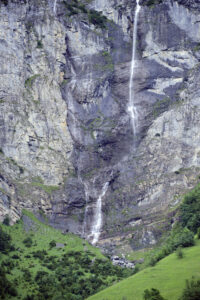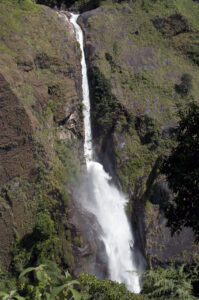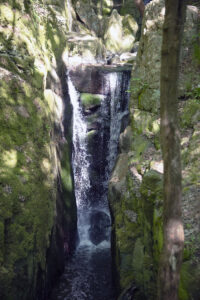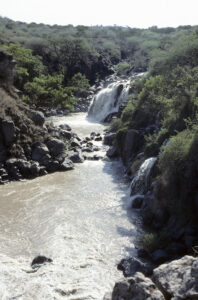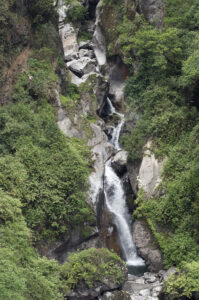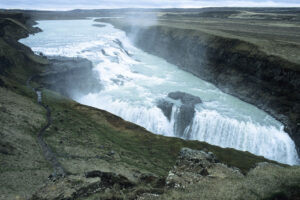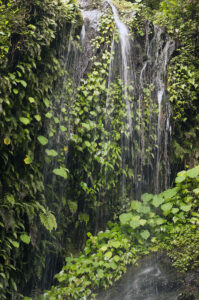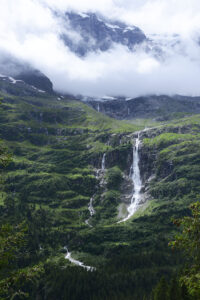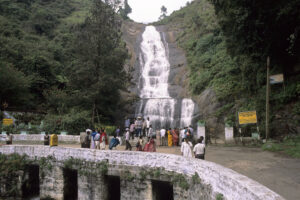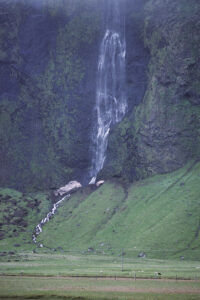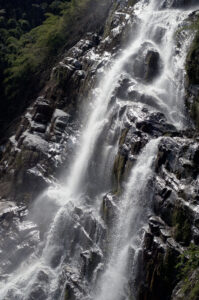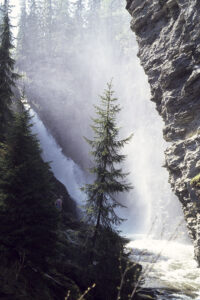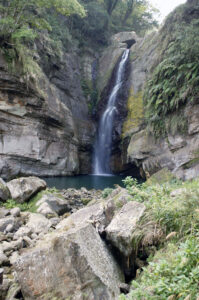Waterfalls
Deposited minerals add gorgeous colours to this rock wall at Lisong Hot Springs, Sinwulu River, eastern Taiwan. (Photo copyright © by Kaj Halberg)
Rainbow at Victoria Falls, or Mosi-oa-Tunya (’The Smoke that Thunders’), Zambezi River, on the border between Zimbabwe and Zambia. (Photo copyright © by Kaj Halberg)
Waterfall, Plitviče Lakes National Park, Croatia. (Photo copyright © by Kaj Halberg)
Horseshoe Fall, Niagara Falls, on the border between Canada and the United States, illuminated at night. (Photo copyright © by Kaj Halberg)
Reichenbachfall is a series of 7 waterfalls with a height of altogether 300 m on the Reichenbach River, near Meiringen, Berner Oberland, Switzerland. At 120 m, the upper waterfall is the highest.
These falls were made famous by British author Arthur Conan Doyle (1859-1930) as the place, where his fictional detective Sherlock Holmes, in The Final Problem, fought against his criminal opponent, Professor Moriarty. Initially, the story ended with the two dying by falling into the falls. However, this caused a chorus of protests among Sherlock Holmes fans, so, ingeniously, Conan Doyle restored Holmes to life in the story The Empty House.
Reichenbachfall. (Photos copyright © by Kaj Halberg)
The fight between Sherlock Holmes and Professor Moriarty at the Reichenbachfall. (Drawing by Sidney Paget, 1893, public domain)
Waterfall on the Vina River, 40 m high, near Ngaunderé, Cameroun. The plant with yellow flowers is Mexican sunflower (Tithonia diversifolia), a pan-tropical weed. (Photo copyright © by Kaj Halberg)
Døndalen is a small valley in eastern Bornholm, Denmark. It was once a canyon, in which the rock faces have moved about 500 m away from each other. The western rockface is still vertical, about 25 m tall.
During the Last Ice Age, parts of the valley became a lake, as a glacier blocked the outlet to the east. In this lake, fine-grained clay was deposited, through which the Døndale Rivulet cut its way. If you follow the bank of the rivulet, you soon encounter the Døndal Waterfall, which has several sections, altogether with a height of about 20 m. In summer, it is not very spectacular – it should be experienced in spring, when the meltwater roars down over the rocks. The Bornholmians use the expression dønnar about the sound, which gave name to the falls.
The Døndal Waterfalls. (Photo copyright © by Kaj Halberg)
Wadi Zarqa Ma’in is a river in the Jordan Valley, southwest of the city Madaba, Jordan. Along this wadi are more than 55 mineral springs with cold or hot water, some with temperatures up to 60oC. The outlet of the river is in the Dead Sea.
Waterfall and hot springs, Wadi Zarqa Ma’in. The plant in the foreground is giant reed (Arundo donax), described on the page Nature: Invasive species. (Photo copyright © by Kaj Halberg)
At 422 m, this waterfall in Cirque de Gavarnie, Pyrenees, is the highest waterfall in France. (Photo copyright © by Kaj Halberg)
Yosemite is a national park in the Sierra Nevada Mountains, California – a varied area with outstanding granite formations, rivers, waterfalls, lakes, meadows, glaciers, large groves of the huge giant sequoia (Sequoiadendron giganteum), and a very rich wildlife. The vegetation of the area is described in depth on the page Plants: Plants of the Sierra Nevada, and the giant sequoia is dealt with on the page Plants: Ancient and huge trees.
Vernal Fall, a 97 m high waterfall in Yosemite National Park. (Photos copyright © by Kaj Halberg)
Nevada Fall, Yosemite National Park, 181 m high. (Photo copyright © by Kaj Halberg)
Waterfall in the Aare River Gorge, near Meiringen, Berner Oberland, Switzerland. (Photo copyright © by Kaj Halberg)
Waterfall and moss-covered rock face, Phortse Tenga, Khumbu, eastern Nepal. (Photo copyright © by Kaj Halberg)
Goðafoss is a number of waterfalls in northern Iceland, located on the river Skjálfandafljót, altogether with a width of about 30 m, and a maximum height of 12 m. The name may mean ‘waterfall of the gods’, referring to two crags at the falls, which resemble pagan idols.
Goðafoss. The plant in the lower picture is mountain avens (Dryas octopetala). (Photos copyright © by Kaj Halberg)
Mules, passing in front of a waterfall, Dharapani, Marsyangdi Valley, Annapurna, Nepal. (Photo copyright © by Kaj Halberg)
This boy is standing beneath a small waterfall at the Pamukkale Terrasses, western Turkey – natural terrasses made from calcium bicarbonate. (Photo copyright © by Kaj Halberg)
On 16 November 1855, Scottish physician and missionary David Livingstone (1813-1873) was exploring the Zambezi River in what is today Zambia. He encountered a huge waterfall on the river, which he named Victoria Falls in honour of Queen Victoria (1819-1901). The local Sotho name of the falls is Mosi-oa-Tunya (‘The Smoke That Thunders’), referring to the roaring sound of the waterfall, and to the mist that rises from evaporation of the water.
Today, Victoria Falls is situated on the border between Zimbabwe and Zambia, as the Zambezi river constitutes the border between the two countries. Although it is neither the highest nor the widest waterfall in the world, it is nevertheless the largest, with a combined width of 1,708 m and a maximum height of 108 m.
Victoria Falls, Zambezi River. (Photos copyright © by Kaj Halberg)
Devil’s Cataract Waterfall (70 m high), Victoria Falls. (Photo copyright © by Kaj Halberg)
During the rainy season, Victoria Falls are often shrouded in mist – here seen from the Zambian side. (Photos copyright © by Kaj Halberg)
Rainbow and mist from Victoria Falls, seen from the Zambezi River. (Photo copyright © by Kaj Halberg)
Huangjin Pubu (‘Golden Waterfall’) with deposited minerals, washed out from former mining shafts, near Jinguashi, northern Taiwan. (Photos copyright © by Kaj Halberg)
Waterfall in Partnachklamm, a 700 m long and 80 m deep gorge in Reintal Valley, Garmisch-Partenkirchen, Bavaria, southern Germany. (Photo copyright © by Kaj Halberg)
Waterfall, near Manali, Himachal Pradesh, northern India. The plant in the lower picture is a species of balsam, Impatiens sulcata. (Photos copyright © by Kaj Halberg)
Fossurin í Fossá (‘The Waterfall in the River of Waterfalls’), near the village Haldórsvík, Streymoy, is one of the highest waterfalls in the Faroe Islands, falling 140 m in two stages.(Photo copyright © by Kaj Halberg)
Taoshan is an 80 m high waterfall in Wuling National Forest, eastern Taiwan. The trees in the upper picture are Taiwan alder (Alnus formosana). (Photos copyright © by Kaj Halberg)
The Blue Nile originates in Lake Tana in the Ethiopian Highlands, from where it makes its way c. 1,500 km to Khartoum, in the Sudan, where it joins the larger White Nile.
The name Blue Nile is in fact a misnomer. During the summer monsoon, this river washes down huge amounts of soil from the highlands, which turns its water almost black. In a local Sudanese language, the word for black is also used for blue, so, in reality, the river should be called ‘The Black Nile’.
The first written account of the Blue Nile is from 1565, when a Portuguese, João Bermudes, who called himself Patriarch of Ethiopia, provided a description of the Blue Nile Falls, Tississat, in his memoirs.
Incidentally, to many Christian Ethiopians, the Blue Nile is identified as the sacred river Gihon, one of the four rivers flowing out from the Garden of Eden, as related in Genesis, 2:13.
Tississat Falls, Blue Nile. (Photos copyright © by Kaj Halberg)
Waterfall, Mokra Mountains, Kosovo. The bush is a white-flowered rose. (Photo copyright © by Kaj Halberg)
Waterfall, Lambir National Park, Sarawak, Borneo. (Photo copyright © by Kaj Halberg)
Waterfalls in the Vrata Valley, Triglavski National Park, Slovenia. The tree in the lower picture is Norway spruce (Picea abies). This tree is described on the page Plants: Ancient and huge trees. (Photos copyright © by Kaj Halberg)
Lava formations in front of the waterfall Hrafnabjargafossar (‘Raven Mountain Falls’), located on the river Skjálfandafljót, northern Iceland. (Photo copyright © by Kaj Halberg)
Chania Waterfalls, Aberdare National Park, Kenya. (Photo copyright © by Kaj Halberg)
Sign along the trail to Chania Waterfalls. (Photo copyright © by Kaj Halberg)
Cascata del Fontanon di Goriuda is a waterfall in the Raccolana Valley in northern Italy, between Chiusaforte and Cave del Predil. The last part of the fall is vertical, dropping about 40 m. Over time, the fall has carved out a small pool at the foot of the rock.
Cascata del Fontanon di Goriuda. (Photos copyright © by Kaj Halberg)
Niagara Falls are 3 waterfalls, situated on the Niagara River, on the border between Ontario, Canada, and New York State. The largest of the falls is Horseshoe Falls, also known as Canadian Falls. The smaller American Falls and Bridal Veil Falls lie within New York State. Bridal Veil Falls is separated from Horseshoe Falls by Goat Island and from American Falls by Luna Island. The highest drop is around 50 m, and more than 168,000 m3 of water goes over the crest of the falls every minute.
Niagara Falls. (Photos copyright © by Kaj Halberg)
American Fall with tourist boat and rainbow. (Photo copyright © by Kaj Halberg)
Tourists at Horseshoe Fall. (Photo copyright © by Kaj Halberg)
Wearing yellow raincoats, tourists are walking through the spray from American Fall. (Photo copyright © by Kaj Halberg)
Dawn in October at Horseshoe Fall. (Photo copyright © by Kaj Halberg)
Through aeons, this small waterfall along Risebæk, a rivulet in western Bornholm, Denmark, has been cutting down into sedimentary rock formations, consisting of c. 450 million years old Dicellograptus slate. The green leaves in the foreground are ramsons (Allium ursinum). (Photo copyright © by Kaj Halberg)
The Boali Waterfalls are situated on the Mbali River, about 100 km northwest of Bangui, the capital of the Central African Republic. Together, they are about 250 m wide, and the highest of the falls is c. 50 m. (Photos copyright © by Kaj Halberg)
Waterfall, Bluntau Valley, near Golling, Salzburg, Austria. (Photo copyright © by Kaj Halberg)
Small waterfall, Rishi Ganga Valley, Nanda Devi National Park, Uttarakhand, northern India. (Photo copyright © by Kaj Halberg)
Plitviče Lakes National Park is a forest reserve in central Croatia, covering 295 km2. It contains 16 terraced lakes, joined by waterfalls, which extend into a limestone canyon.
Waterfalls, Plitviče Lakes National Park. (Photos copyright © by Kaj Halberg)
Desian Waterfall, near Lugu, western Taiwan. (Photo copyright © by Kaj Halberg)
Stora Sjöfallet (‘The Great Lake Falls’), in Sami Stuormuorkkegårttje (‘The Great Fall in the Land between Two Lakes’) is a waterfall in Swedish Lappland, which was once among the most powerful and striking waterfalls in Europe. The fall and the surrounding area was declared a national park in 1909, but already in 1913 the government permitted a hydroelectric plant to be built at the falls, with power lines, roads, and gravel banks. Due to the extensive damage of the area, the fall is no longer a part of the national park. A dam created an artificial lake, called Áhkkájávre, named after a nearby mountain massif.
A few times a year, for the benefit of tourists, a large amount of water is allowed to flow through Stora Sjöfallet. This happened on the day that I visited the fall. (Photo Jørn Halberg, copyright © by Kaj Halberg)
Waterfall, Capo Matapalo, Peninsula de Osa, Costa Rica. (Photo copyright © by Kaj Halberg)
Svartifoss (‘Black Falls’), Skaftafell, Vatnajökull National Park, southern Iceland, is only 20 m high, but is nevertheless very spectacular, due to the dark hexagonal basalt columns around it, which gave rise to its name. (Photos copyright © by Kaj Halberg)
Låtefoss is a 165 m long waterfall, located in Vestland County, south-western Norway. This waterfall consists of two separate streams, flowing down from Lake Lotevatnet, joining just before running under the National Road 13. (Photo copyright © by Kaj Halberg)
Kalhatti Waterfalls are located c. 15 km from the town of Ooty in the Nilgiri Mountains, Tamil Nadu, southern India. The falls can only be reached by foot, hiking 3 km from Kalhatti Village. According to local folklore, the Hindu Brahman Agastya spent some time in these parts. He is revered as the Brahman who brought Sanskrit-speaking civilization to South India. It is believed that he received many of the earliest mantras in the Rig Veda directly from the supreme god Brahma.
Kalhatti Waterfalls. The flowers are marigolds (Tagetes). (Photos copyright © by Kaj Halberg)
Waterfall, Stechelberg, Lauterbrunnen Valley, Berner Oberland, Switzerland. (Photo copyright © by Kaj Halberg)
Waterfall, Chamje, Marsyangdi Valley, Annapurna, Nepal. (Photo copyright © by Kaj Halberg)
The Kobbeåen is a small rivulet on the east coast of the island Bornholm, Denmark, which makes its way through a former canyon. Several rock faces still rise vertically from the water. This valley contains the tallest waterfall in Denmark – that is if you talk about a free fall. It is 4 m tall, and through aeons, it has cut another 4 m down into the surrounding rock.
The fall is called Stavehøl, but in reality it is the name of a small pool in a hollow, which the fall has eroded into the rock, in Bornholmian høl. The fall should be experienced in spring, when the water is roaring down through the narrow canyon. Late in the summer, the amount of water rather resembles what comes out of a garden hose!
Stavehøl Waterfall, Kobbeå Valley. (Photo copyright © by Kaj Halberg)
On the Awash River, Awash National Park, Ethiopia, are several waterfalls, together more than 100 m wide, and 50 m high at the highest point. (Photo copyright © by Kaj Halberg)
Waterfall, Surkhe, Solu-Khumbu, eastern Nepal. (Photo copyright © by Kaj Halberg)
Gullfoss (‘Golden Falls’) is a waterfall, located in the canyon of the Hvítá River, south-western Iceland. The fall plunges in two stages, 11 and 21 m, into a 32 m deep, 20 m wide, and 2.5 km long canyon. The average amount of water in the fall is 141 m3 per second in the summer, and 80 m3 per second in the winter, with a record of a stunning 2,000 m3 per second.
In the 1900s, there was much talk about using Gullfoss to generate electricity, but luckily it was given up, partly due to lack of money. Today, the waterfall is protected.
Gullfoss. (Photo copyright © by Kaj Halberg)
Small waterfall, Mingtsih, Taiwan. (Photo copyright © by Kaj Halberg)
Waterfall, Tsingelhorn, Lauterbrunnen Valley, Berner Oberland, Switzerland. (Photo copyright © by Kaj Halberg)
The Silver Cascade Waterfall is about 54 m high, situated about 8 km from Kodaikanal, on the Madurai-Kodaikanal road in Western Ghats, Tamil Nadu, South India. (Photo copyright © by Kaj Halberg)
Seljalandsfoss is a waterfall on the Seljalands River, which originates in the glacier Eyjafjallajökull, southern Iceland. The fall drops 60 m, and visitors can walk behind it into a small cave. (Photo copyright © by Kaj Halberg)
Waterfall on dark rocks, Tal, Marsyangdi Valley, Annapurna, Nepal. (Photo copyright © by Kaj Halberg)
Brakkåfallet, a waterfall in two parts close to Stora Blåsjön, north of Gäddede, Jämtland, Sweden. (Photo copyright © by Kaj Halberg)
Waterfall, Brahmagiri Mountains, Karnataka, South India. (Photo copyright © by Kaj Halberg)
Yuantan Waterfall, near Chiayi, western Taiwan. (Photo copyright © by Kaj Halberg)
(Uploaded May 2024)
